MagCapture™ EV Isolation Kit PS for HTS
Extracellular vesicles (EVs), such as exosomes, are involved in more than just eliminating waste products from the body; they also serve as mediators of intercellular communication. The properties of EVs and their contents (nucleic acids, proteins, lipids, etc.) vary depending on the cell that secretes them. In liquid biopsy, a procedure for diagnosing diseases using body fluid samples, these cell-derived EVs and their contents are being explored as potential biomarkers.
The development and practical application of liquid biopsy require technology capable of efficiently isolating and purifying EVs from numerous samples. However, conventional methods, like ultracentrifugation, are limited in the number of samples that can be processed simultaneously. Consequently, the isolation and purification of EVs from many samples using these methods takes considerable time and effort.
To address this, Fujifilm Wako has developed the MagCapture™ EV Isolation Kit PS for HTS, compatible with automated extraction devices such as KingFisher™ Flex (Thermo Fisher Scientific Inc.), commonly used for nucleic acid and protein extraction. This kit, utilizing the PS affinity method1)--a proprietary EV isolation and purification technique developed in collaboration with Prof. Hanayama of Kanazawa University--enables the isolation and purification of high-purity EVs with minimal damage from up to 96 samples at once using automated extraction equipment.
Product Overview
The MagCapture™ EV Isolation Kit PS for HTS, utilizing the PS affinity method, is designed for the isolation and purification of extracellular vesicles (EVs) for use with automated extraction devices, such as the KingFisher™ Flex (Thermo Fisher Scientific Inc.). It enables the isolation and purification of EVs, including exosomes, from up to 96 samples at once, making it highly suitable for biomarker discovery and high-throughput screening (HTS) applications in EV research.
Features
- Using an automated extraction device, this kit allows the isolation and purification of EVs from up to 96 samples simultaneously.
- Enables the isolation of high-purity EVs with minimal damage.
Samples (example)
- Cell Culture Supernatant
- Serum
- Plasma
- Urine
- Saliva
Compatible automated extraction devices
(with proven isolation performance)
- KingFisher™ Flex (Thermo Fisher Scientific Inc.)
Comparison with manual kit (MagCapture™ Exosome Isolation Kit PS Ver.2)
Compared to the MagCapture™ Exosome Isolation Kit PS Ver.2 (Product No. 290-84103), which is designed for manual isolation and purification, this kit differs in the following respects. Note that the EV recovery efficiency is comparable (see “Performance Data” for details).
| Automated extraction (MagCapture™ EV Isolation Kit PS for HTS) |
Manual extraction (MagCapture™ Exosome Isolation Kit PS Ver.2) |
|
|---|---|---|
| Method by which Tim4 binds to magnetic beads | Directly prebound: Tim4 is already bound to the magnetic beads, eliminating the need for a separate binding step. | Avidin-biotin mediated: Tim4 binds to magnetic beads through the avidin-biotin interaction, requiring an additional step for Tim4 binding. |
| Detergent concentration in the elution buffer | High: To minimize the loss of magnetic beads. | Low |
| EDTA concentration in the elution buffer | High: To reduce the number of elution steps. | Low |
Principle
The PS affinity method, Fujifilm Wako’s proprietary EV isolation technique, utilizes the Tim4 protein, which specifically binds to phosphatidylserine (PS) present on the surface of EVs. The high specificity of the PS-Tim4 interaction, coupled with the gentle elution by a chelating agent, enables the isolation of high-purity EVs in their intact state.
-
Capture
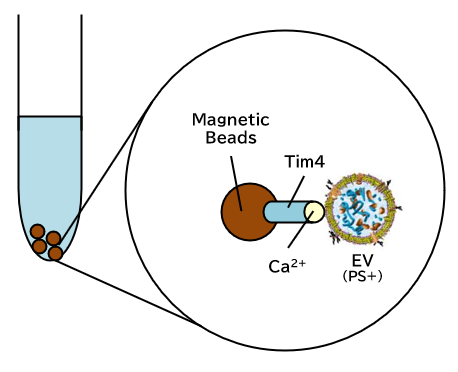
-
Elution
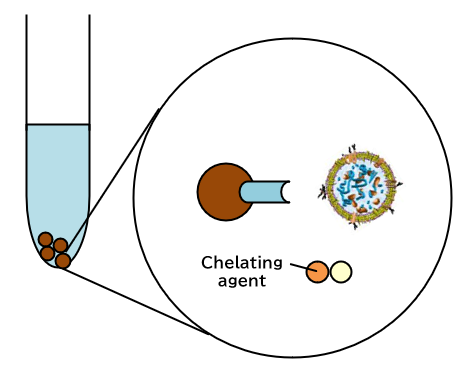
Protocol
Isolation and purification of EVs using KingFisher™ Flex
(when performing the affinity reaction and elution in a single run)
pretreatment
[Manual]
01
Centrifuge the samples to precipitate impurities and collect the supernatants.
preparation
[Manual]
02
Prepare the EV Washing Buffer (1x) and EV Elution Buffer (1x).
preparation
[Manual]
03
Dispense the samples into 1.5 mL microtubes and add EV Binding Enhancer.
04
Prepare each of the following seven types of plates.
| Plate name (example) | Prepare |
|---|---|
| (1) Tip1 | Place the tip comb in a 96 deep-well plate. |
| (2) DWP1_Beads | Add 60 μL of EV Capture Magnetic Beads and 940 μL of EV Washing Buffer (1x) to the designated wells. |
| (3) DWP2_sample | Add 1 mL of samples to the same well positions as in “(2) DWP1_Beads”. |
| (4) DWP3_Washing | Add 1 mL of EV Washing Buffer (1x) to the same well positions as in “(2) DWP1_Beads”. |
| (5) DWP4_Washing | |
| (6) DWP5_Washing | |
| (7) DWP6_Elution | Add 100 μL of EV Elution Buffer (1x) to the same well positions as in “(2) DWP1_Beads”. |
and purification
[Automated]
05
Launch the KingFisher™ Flex and select the pre-set protocol.
06
Place the plates and tips in their designated positions and start the processing program.
07
Retrieve the plates and tips from the device. The plate labeled “DWP6_Elution” contains the isolated EVs.
Note: To potentially reduce the carryover of impurities from the samples, consider performing the affinity reaction and elution as separate programs, using a new tip comb for elution. For more details, please refer to the instruction manual.
[Protocol] Isolation and purification of EVs for high-throughput screening
(Youtube 2:36)
Data
Performance Data
Particle count comparison with the manual kit by NTA
EVs were isolated and purified from various samples (serum, heparin plasma, urine, and COLO 201 cell culture supernatant) using the MagCapture™ EV Isolation Kit PS for HTS (Auto) or MagCapture™ Exosome Isolation Kit PS Ver.2 (Manual). The number of EV particles was quantified by Nanoparticle Tracking Analysis (NTA).
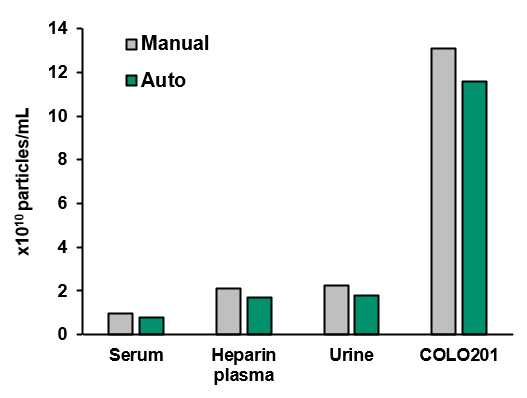
[Result]
The MagCapture™ EV Isolation Kit PS for HTS yielded a comparable number of particles to those obtained with the manual kit.
Comparison of EV recovery with the manual kit as measured by ELISA
EVs were isolated and purified from various samples (serum, heparin plasma, urine, and COLO 201 cell culture supernatant) using the MagCapture™ EV Isolation Kit PS for HTS (Auto) or MagCapture™ Exosome Isolation Kit PS Ver.2 (Manual). EV recovery was measured using the PS Capture™ Exosome ELISA Kit (Streptavidin HRP) (Code No. 298-80601).
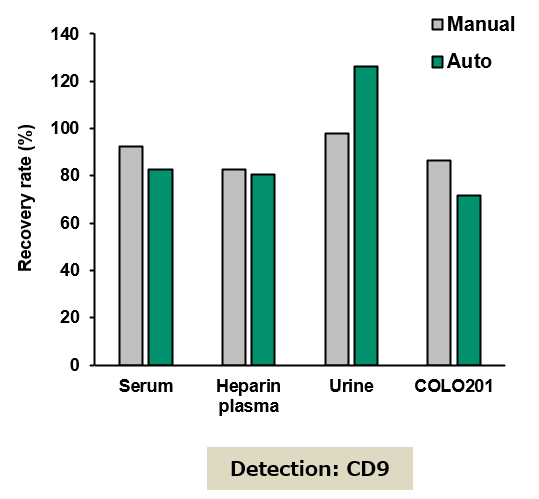
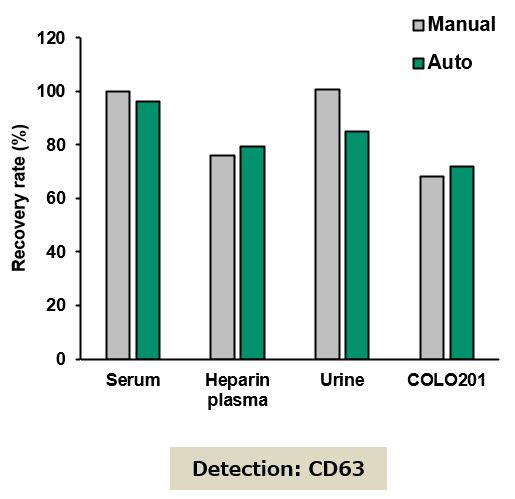
[Result]
The rate of recovery achieved using the MagCapture™ EV Isolation Kit PS for HTS was comparable to the manual kit.
Comparison with the manual kit using proteomics analysis
EVs were isolated and purified from 200 μL of human serum using the MagCapture™ EV Isolation Kit PS for HTS (Automatic/Automated) or MagCapture™ Exosome Isolation Kit PS Ver.2 (Manual). Proteomic analysis was performed on the resulting EV solutions.
(1) Identified protein species

[Result]
The number of proteins identified across four trials was consistently higher with the MagCapture™ EV Isolation Kit PS for HTS compared to the manual kit, suggesting higher reproducibility.
(2) Amount of EV marker proteins
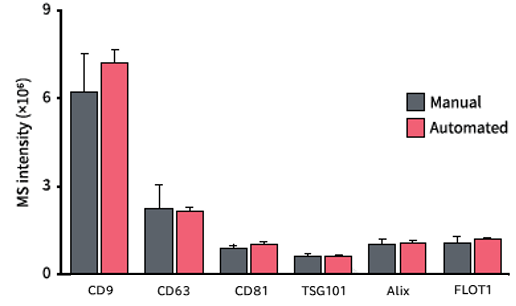
[Result]
There was no significant difference in the amount of EV marker proteins in EVs isolated using either the MagCapture™ EV Isolation Kit PS for HTS or the manual kit, indicating that automation did not affect the yield of EVs.
(3) Amount of a non-EV marker protein (albumin)
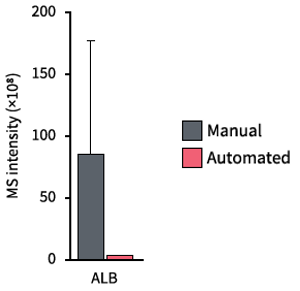
[Result]
The amount of non-EV marker albumin was lower with the MagCapture™ EV Isolation Kit PS for HTS compared to the manual kit, indicating fewer impurities in recovered EVs.
About commercial or for-profit purposes
Please use this product for research purposes only. If you wish to use it for commercial or for-profit purposes, please contact Fujifilm Wako at wkuslabchem@fujifilm.com.
References
- Nakai, W. et al.: Sci. Rep. 6(1), 1(2016).
A novel affinity-based method for the isolation of highly purified extracellular vesicles
Product List
- Open All
- Close All
MagCapture™ EV Isolation Kit PS for HTS
For research use or further manufacturing use only. Not for use in diagnostic procedures.
Product content may differ from the actual image due to minor specification changes etc.
If the revision of product standards and packaging standards has been made, there is a case where the actual product specifications and images are different.




